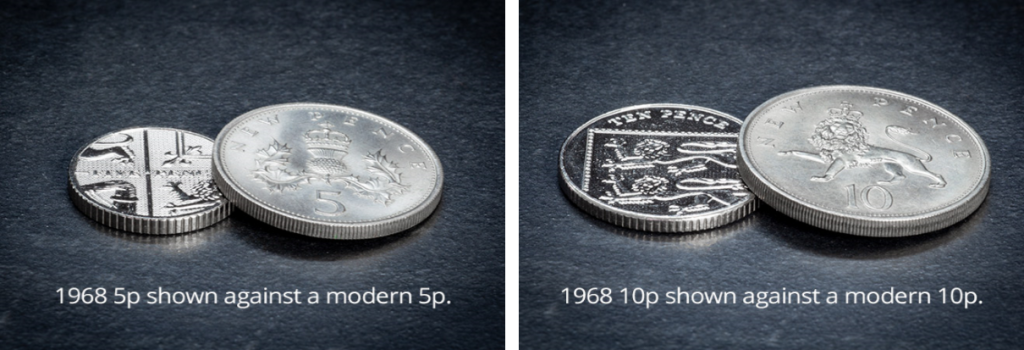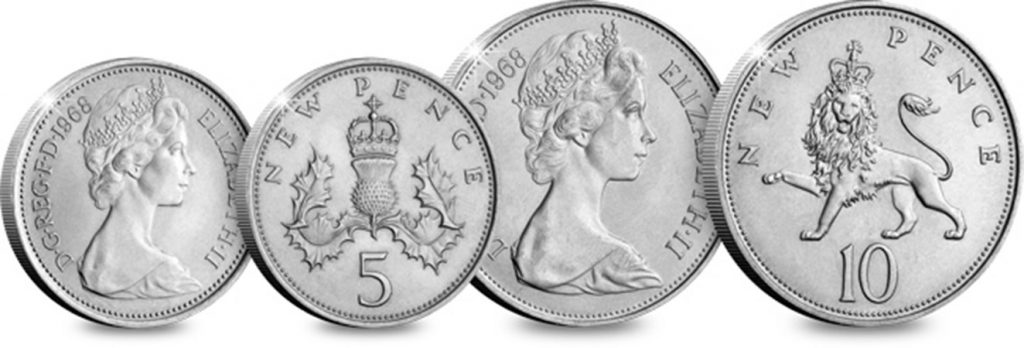Posts Tagged ‘decimal currency’
A deep dive into decimalisation…
In 1971, Britain officially went ‘decimal’ after a long period of campaigns in preparation for the move.

The transition to decimalisation was the biggest change to the UK’s monetary system in over 1000 years and understably was met with caution by the public.
Rationale presented by decimal enthusiasts was opposed by those who were cautious of the effects of a new decimal coinage system.
In this blog, we take a close look at this controversial monetary move as we take a deep dive into Decimalisation…
The Decimal Debate
For centuries, Britain’s coinage consisted of pounds, shillings, pence, farthings, crowns, half pennies… the list goes on!
This complex system had first been raised for debate in 1847 by Sir John Bowring, who proposed a call for it to be changed to a currency based on units of ten. As a result of his proposal, the nation’s first decimal coin appeared – the farthing.

It wasn’t until 1961 however, that the Government set up a special committee to think about whether Britain should introduce a decimal currency.
On 1 March 1966 the Chancellor of the Exchequer, James Callaghan, announced that pounds, shillings and pence would be replaced by a decimal currency, with a hundred units in a pound.
Making the Change
The changeover was a huge task and the public and businesses of Britain required all the necessary information to make the changeover as smooth as possible.

The volume of coins required to be produced was far greater than The Royal Mint’s production capabilities at Tower Hill and it brought about their move to Llantrisant, South Wales, in 1968. It was here that the first of almost six billion coins required for decimalisation went into production.

In 1968 the new 5p and 10p coins were introduced. They were the same size and value as the existing one and two shilling coins to make the transition easier for the British public.
It was in 1969 that the first seven sided coin – the 50p – was introduced to replace the 10-shilling note as a more economical alternative and then finally, on Monday 15 February 1971, the transition was complete when the half penny, 1p and 2p coins were also introduced.
Our Dear Decimals
From Britannia to the Royal Shield design, we’ve grown to love our decimal coins but in their 50th anniversary year, it’s wonderful to see the journey they’ve made.

We’ve seen over 100 different designs of our 50p coin since it’s introduction in 1969, over 60 different £2 coin designs since 1986, and a complete re-design of our £1 coin’s specification to a 12-sided coin, from the original round pounds in 1983.
In 2018 we even saw our first-ever commemorative 10p coins, with over 26 designs celebrating quintessentially British icons!
We’ve certainly been blessed with lots of decimal coins to collect and here’s hoping there’s many more to come! There’s not been a new £1 coin design since 2016 so perhaps that will come next…
Let us know in the comments which decimal coin is your favourite!
Secure the Complete Decimal Coin Collection!

This Complete Decimal Coin Collection includes the 14 coins which were affected by the decimal changeover, presented in a bespoke Change Checker display page!
Secure one for your collection for JUST £30 (+p&p) by clicking here >>
The 50 Day Countdown to the 50th Anniversary of Decimalisation has BEGUN!
The countdown has begun and in JUST 50 days, our decimal coinage will celebrate its 50th anniversary!
Join in with our celebrations!
To celebrate the anniversary of the biggest change our UK coinage has ever seen, we’ve launched a 50 Day Countdown until the Decimalisation Anniversary!
Every day, for 50 days, we’ll be posting different activities for you to read, watch and get involved in. We’ve got quizzes, giveaways and so much more planned, so make sure you’ve got your eyes peeled across all of our channels so that you can get involved!
The 50th anniversary of Decimal Day marks a significant change in our UK currency which changed the day to day lives of every British Citizen in the United Kingdom.
It was the subject of passionate debate for centuries, so during our 50 Day Countdown, we’ll be taking a closer look at the history and story behind the decimal changeover. To test your knowledge, we’ll even have some quizzes for you to get involved with!
So, will you be joining us on our Countdown?
Make sure you’ve subscribed to the Change Checker Podcast, our Youtube channel and you’ve followed us on Facebook, Instagram, and Twitter to make sure you don’t miss out on some of the exciting prizes up for grabs!
If you have memories of the changeover, or have any interesting facts about Decimalisation, make sure you’re commenting below!
Secure the 14 coins which were affected by the decimal changeover with the Decimalisation Collector Page!
This collector page includes space to display the 14 coins which were affected by the decimal changeover on ‘D-Day’ in 1971 and makes for the perfect heirloom for any aspiring collector, or for those interested in the heritage of British coins.
Using secure push-fit blisters to display each coin in the collection, your collector page is also designed to fit neatly inside the Change Checker Album.
Secure yours for JUST £30.00 (+p&p) when you click here >>
50 years since the most important moment in British numismatic history…
2018 marks the 50th anniversary of arguably the most important moment in British numismatic history – the first coins issued for decimalisation.
In 1968, the British public would have found 5p and 10p coins in their change for the very first time, issued as part of Britain’s conversion to a system of decimal currency.

1968 5p and 10p coins
The coins bore new heraldic designs, but were exactly the same size and value as shillings and florins, which meant the changeover process should have been a smooth transition. However, after generations of pounds, shillings and pence, the Decimal Currency Board still needed to reassure suspicious Britons to go decimal – a case which had actually been argued as long ago as 1696 by Sir Christopher Wren.

Advert from the Decimal Currency Board. Credit: Daily Mail
It was the 1960 report by the Association of British Chambers of Commerce and the British Association for the Advancement of Science which finally set into action a currency based upon simple multiples, a system already adopted by a number of Commonwealth countries including Australia, New Zealand and South Africa.
A massive number of coins were required for the changeover, forcing The Royal Mint to move location from Tower Hill to its new production facility in Llantrisant, South Wales, where the first of almost six billion coins required for decimalisation went into production.

The Royal Mint at Tower Hill, London. Credit: The Royal Mint museum
It was then on the 23rd April 1968 that the new 5p and 10p coins went into circulation, operating as legal tender up to the sum of £5, with mintage figures of 98,868,250 and 336,143,250 respectively.
The humble 5p featured the Christopher Ironside reverse design until 2008 and has since featured Matthew Dent’s reverse design, following a public competition held by The Royal Mint. On the 27th June 1990, a reduced size version of the coin was introduced and the older, larger coins were withdrawn on the 31st December 1990, although the design remained unchanged.
Similarly, the 10p coin also featured Christopher Ironside’s reverse design up until 2008 when this was replaced by Matthew Dent’s. However, the 10p remained a larger coin until the 30th September 1992, when the reduced size version was introduced, with the larger coin being removed from circulation a year later.

As we seem to move ever closer towards a cashless society, the questions lingers as to how long these decimalised coins will remain a necessity… However, this year’s release of 26 brand new A-Z of Great Britain 10p coin designs just goes to show that the demand for the smaller denomination coins is still there. In fact, these little coins have become incredibly sought-after and have dominated news stories and conversations amongst collectors, with everyone wanting to get their hands on the elusive coins!
Although the nation seemed reluctant to accept these decimal coins back in 1968, I think it’s fair to say that they have now become a much loved part of British coinage and as we celebrate the 50th anniversary of the first decimalised coins, we can look back with fondness for the 5p and 10p coins.
Own the very first coins issued for decimalisation!
The First Decimalised Coins include the original 5p and 10p coins from their first year of issue, 1968.
Order yours today to mark the 50th anniversary of the introduction of these significant coins >>


